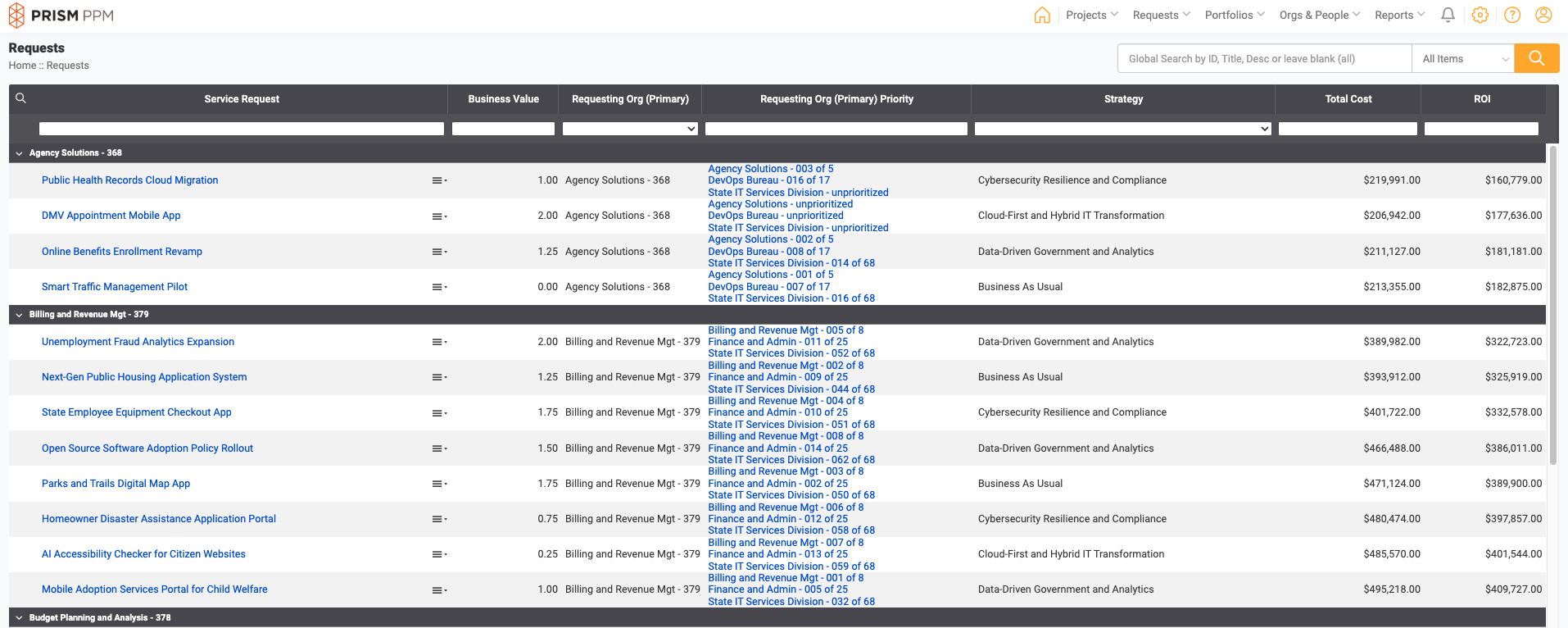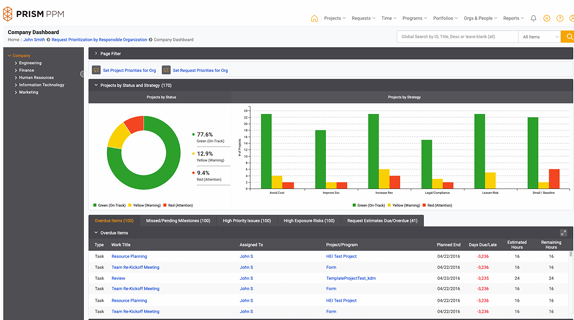Gone are the days when you can handle project management through spreadsheets alone. Manual processes simply aren’t efficient or accessible. Eighty percent of organizations see eliminating data and information silos as an essential priority.
You need a solution to curb costs and simplify project management. Basic collaboration and task management tools can help you complete some kinds of projects. Still, they might miss the mark when it comes to long-term projects with complex staffing needs or regulatory considerations. A project portfolio management tool is the answer.
Perhaps you’re overwhelmed by the number of tools available. Or, you’re not sure what challenges a good PPM should solve. Perhaps you’re unsure how to future-proof your project management software decision.
PPM software selection doesn’t necessarily come intuitively, given the vast array of project portfolio management tools available. This article is designed to help PMOs and decision-makers navigate the often-overwhelming PPM software landscape.
Why Do You Need a Project Portfolio Management Software Solution?
Your PMO needs a tool that supports strategy, not just schedules.
A PPM software solution enables project portfolio prioritization, allowing you to align individual projects with your overarching strategies and focus on the initiatives that will bring you the most value. Your selected tool will provide visibility into performance and help ensure that you can accommodate multiple high-stakes projects.

You’ve outgrown your current task management platform.
Legacy systems are often built just for delivery and don’t provide insight into outcomes or cost control. They can’t accommodate the many projects in your portfolio or provide you with the structured approach you need to manage project portfolios effectively. Newer models offer greater automation and efficiency, giving you a comprehensive system for project prioritization and management.
You need a central repository that bridges departments and provides comprehensive support.
PPM systems fold resource management, project planning, and reporting into a single platform, ensuring greater oversight and progress tracking. They also incorporate communication and budgeting tools and facilitate better decision-making for your entire organization.
CWM vs PPM vs SPM
When you’re grappling with the various portfolio project management tools, you’ll come across different terminology that may be confusing, including collaborative work management (CWM), project portfolio management (PPM), and strategic portfolio management (SPM). What’s the difference, and when should you use each approach or tool?
Collaborative Work Management
CWM focuses on collaboration within given projects or within an organization. This approach ensures the communication and coordination of projects and tasks.
A CWM solution offers a platform for tracking productivity and providing visibility across projects, responsibilities, and tasks. It tends to be used by SMEs where team collaboration is paramount.
Project Portfolio Management
PPM is an approach to managing a portfolio or collection of projects to meet larger organizational goals. Focusing on alignment, it is a framework for choosing the right projects and prioritizing them appropriately, enabling you to choose the best projects that complement your overarching goals.
The right PPM software solution helps you assess progress, timelines, milestones, data, and risks for individual projects as well as the comprehensive project portfolio. This leads to stronger benefits realization.
Strategic Portfolio Management
The SPM approach aligns portfolios with longer-term strategy and goals. It allows you to prioritize and choose the projects that will further your objectives. The scope includes a variety of initiatives and tasks, not solely projects, toward the goal of strengthening impact.
Essentially, SPM is about maximizing value. It is a proactive approach to examining opportunities and ensuring you don’t miss out, providing a roadmap for the PPM strategy to be carried out.

PPM Software Selection Criteria
So, how do you go about the process of vendor selection for PMO software?
Portfolio project management software should meet your unique challenges. There is no one-size-fits-all approach. The costliest one isn’t necessarily the best one, nor is the cheapest. When you’re choosing the right platform for your organization, consider these factors.
Goals and Objectives
Begin with your overarching organizational goals, outlining your PPM strategy and measurable goals. For example, what are the KPIs you’re evaluating? Look for a tool that provides insight into real-time status and staffing so you can track performance and project health.
Support You Need
What’s the purpose of any tool if you don’t know how to use it or maximize its value? This is why it’s essential to evaluate user-friendliness. Your PPM platform should be easy to navigate and scalable. It must account for current capabilities as well as future capabilities you could need.
Integration support is also important. The tool must connect or share data with systems as diverse as file-sharing solutions to business analytics software.
To evaluate these qualities, ensure you can view the company’s case studies, receive a demo, and/or get a trial period to test out features and complexity. The more closely you can examine a PPM, the better you’ll understand how the tool will complement your organizational needs and how it can be tailored to match your goals.
Features
The features you look for in a PPM platform vary by goals, nature of the organization, and other factors. Here are the features most organizations will need:
- Project management including detailed task plans, templates and custom workflows
- Resource management capabilities
- Reporting and dashboards with real-time data
- Financial management
- Automation
- Various APIs
- Compliance support for any laws and regulations you must follow in your industry and area of operation
- Customizability and flexibility
- Support with implementation and ongoing support
Stakeholder Buy-in
It’s normal to face resistance from employees and stakeholders. They could be used to doing things a certain way, even if that way is outdated and inefficient. In order to attain buy-in, you will need to educate stakeholders on the value of the PPM tool.
Focus on the improvements the PPM solution will offer, rather than the ways the tool could replace any human individuals or responsibilities; improved staffing and utilization, visibility into capacity to take on new work, and time saved from automation are all benefits everyone can enjoy. Reassure them about the value, and involve them in the decision-making process, allowing them to have input when you choose a PPM tool.
Remember: The PPM software solution you choose is not just a tool for the PMO office but for the entire organization. As part of your “sales pitch,” remind each team member of the various ways the platform will improve efficiency for them and their role. Inviting them to view a live or recorded demo is a helpful way to loop in peripheral stakeholders; even if they won’t spend a lot of time using the platform, they still need to be bought in.
Timeline
What timeline are you looking at in terms of support and implementation? Consider commitment time: How long is the contract? What’s the renewal process like?
If the PPM tool is a new platform, you probably want to choose a low-risk tool with a shorter-term investment. This is also true if you want to be able to try the platform out for a longer period of time before committing.
Budget
It’s not as simple as choosing the least expensive PPM tool. Platforms that seem cheap upfront are often too good to be true; they are either not a PPM or require costly modules on top of the basic platform fee.
Many inexpensive tools are only less costly on the surface; they will incur steep maintenance fees later on. Moreover, software that is too complex to navigate will take more time to use (time that comes out of your busy day)—which costs you more money, even if the upfront costs aren’t steep.
That’s why you need to understand the comprehensive cost structure, not just initial fees. Find out exactly what’s included, such as support for a given time period. If you need to buy other tools to integrate with the software, for example, you could face even higher costs than you would with a more expensive platform that includes all of these features.
PPM Software Checklist
- Features
- Project Management
- Customizable workflows
- Resource management
- Dashboards/reporting
- Risk registries
- Time tracking
- Notifications/alerts
- Financial management
- Roadmaps
- Navigable
- User-friendly interface
- Easy maintenance
- Support for integration
- Implementation support
- Support for agile approaches
Prism PPM: A Scalable PPM Solution
Strategic project management software solutions don’t just help the PMO. They aid the entire organization.
Prism PPM is a scalable solution that enables better visibility into project pipeline as well as in-flight projects. It captures requests and ideas via a centralized intake tool and ensures better project prioritization with the Business Value Assessment tool.
Map your project lifecycle with our Visual Workflow, viewing the project pipeline by stage, department, and more, and leverage Prism’s Strategy Mapping and Portfolio Roadmaps.
You can also optimize staffing through Resource Management features. Forecast resource availability to avoid under or overutilization, and curb risks with “What If” scenarios which allow you to evaluate the impact of various resource changes in real-time, so you can understand the impact of change across all projects before making a move.
Integrations with tools like Jira allow your teams to work in their agile tools while key data is pulling into Prism for tracking and reporting. You can also receive automated alerts about changes, keeping everyone aligned and informed. Meanwhile, reports and dynamic dashboards give you visibility at every level and real-time insights.
Prism PPM is a secure and compliant tool that is SOC2 Type 2-certified and HIPAA compliant, offers reportable audit detail logs, and supports Single Sign-On and Multi-Factor Authentication.
Conclusion: Choosing the Best PPM Solution
When you’re choosing the right PPM solution for your organization, it is essential to conduct a thorough project management software evaluation. Choose the platform that meets your needs and supports scalability. You want a tool that will grow with your organization. Your PPM tool should facilitate easier collaboration and coordination between teams and within the overall organization.
Prism PPM offers abundant features for project planning and portfolio management, bridging the gap between strategy and execution. Download our comprehensive PPM Buyer’s Guide for a more detailed look at how to choose the right platform for your business.